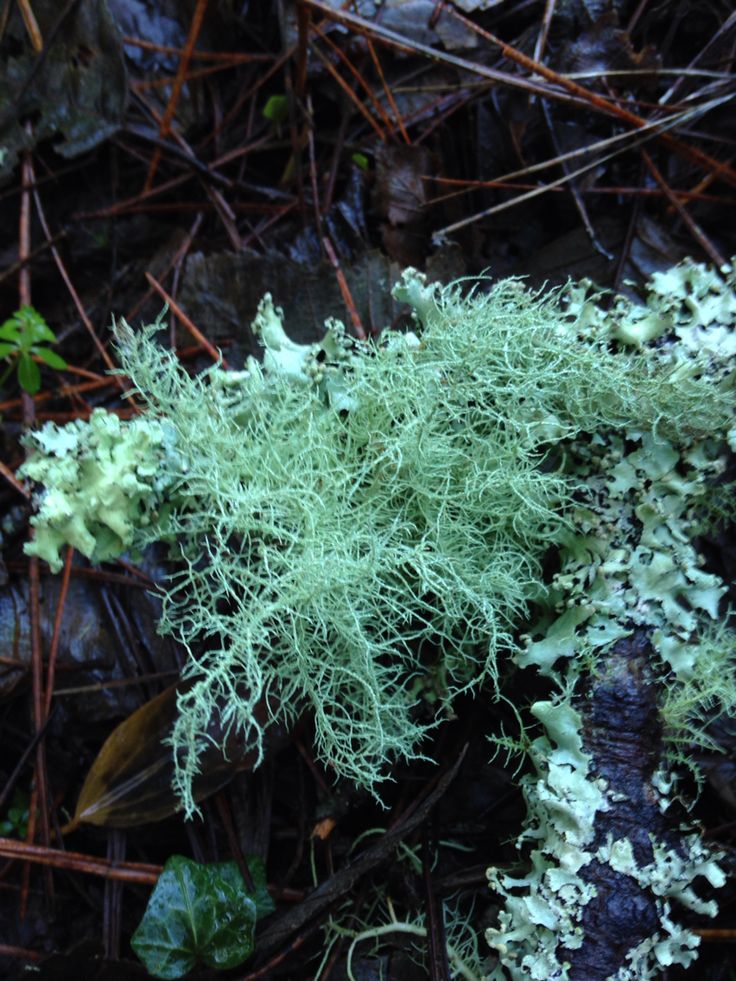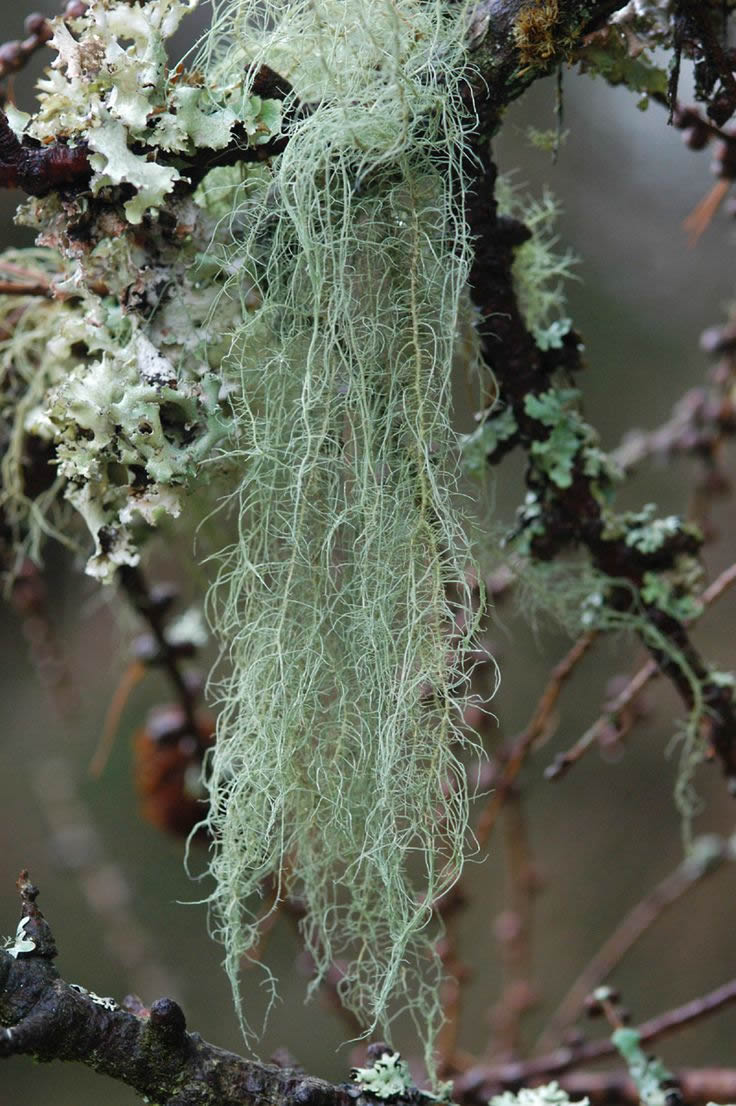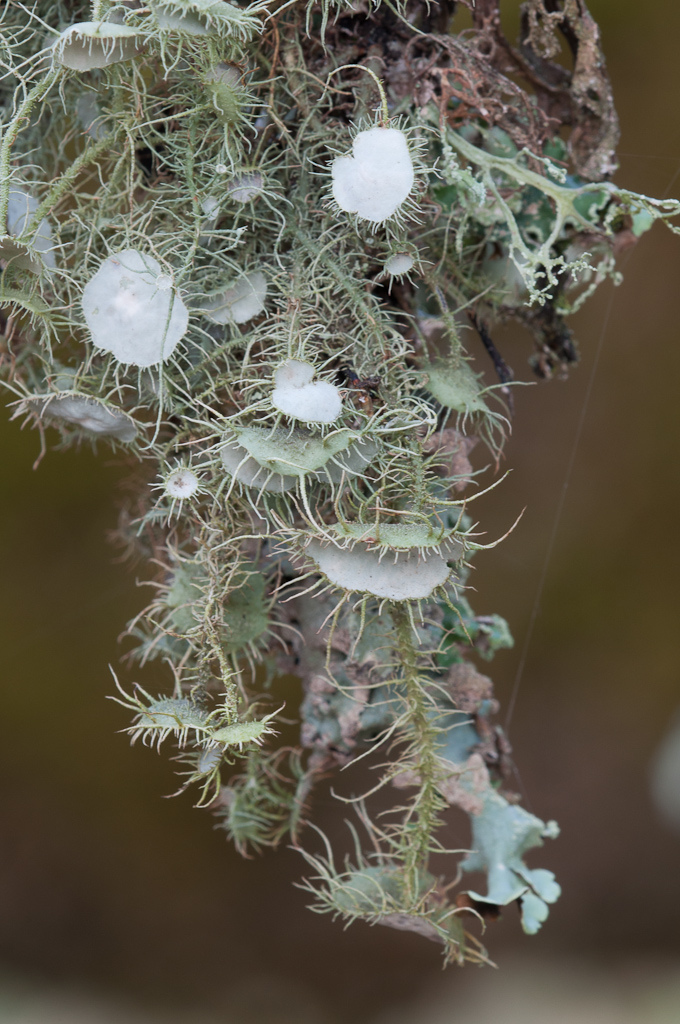 |
| Usnea |
Usnea is a unique species of herb because it is created through a symbiotic relationship between lichens and algae. Symbiosis refers to the living together of two different organisms.
In the case of lichens, both the alga and the fungus benefit from the relationship. Other names for usnea include lichen moss and old man’s beard. Usnea can be found in forests in northern North America and are also found in Europe.
Some usnea are able to keep growing even after being broken off from the parent organism. Usnea are very sensitive to the air quality and may be killed by absorbing pollutants. In fact, usnea are used as indicators of regional pollution levels.
When a fungus and an alga combine, the resulting organism does not resemble either component. The fungal component has the main influence over the appearance and is the determinant for the species name of each lichen.
The local environment also influences the appearance of the lichen. In general, usnea appear as long, hairy or fuzzy strings that hang from trees, rocks, and decomposing wood.
The fibers (branches) of usnea are round and contain a slender white cord at the core. During wet conditions, the white cord has elastic properties. Lichens are usually gray or green in color that varies depending upon the algal component. For instance, green lichens have a green algal component.
 |
| Usnea are very sensitive to the air quality |
The primary active ingredient in usnea is usnic acid. Usnic acid protects the lichen from overexposure to light and its bitter taste prevents invertebrates (creatures that lack a spinal cord) from eating it. Usnic acid has antibacterial and antitumor activities.
Against certain bacteria, usnic acid is stronger than the antibiotic penicillin. Usnic acid is effective against gram-positive bacteria including Streptococcus, Staphylococcus, and Pneumococcus but, unlike many antibiotics, does not harm the gram-negative bacteria that live in the gut and vagina.
It is also effective against the bacterium that causes tuberculosis and may be effective against certain fungi and protozoans (simple, single-celled organisms such as trichomonas). It is believed that usnic acid works by disrupting the metabolism (the chemical and physical processes of an organism) of bacteria while leaving human cells unharmed.
Usnea contains mucilage, which can help ease coughing. It also has expectorant (brings up lung mucous) activity. Mucilage is a thick slimy substance produced by plants that has a soothing effect on mucous membranes. Herbalists consider usnea a muscle relaxant and an immune system stimulant.
Other constituents of usnea species may include barbatolic, evernic, lobaric, tartaric, thamnolic, stictinic, and usnaric acids.
General use
Usnea was historically used to treat indigestion because of its bitter taste and activity as a digestive system stimulant. The peoples of ancient China, Egypt, and Greece used usnea to treat infections. In the fourteenth century, it was believed that usnea could strengthen hair because of its hair-like appearance.
Usnea is used to treat abscesses, colds, cough, cystitis, fungal infections (such as athletes foot or ringworm), gastrointestinal (stomach and intestine) irritations, influenza, sore throats (including strep throat), respiratory infections (sinusitis, bronchitis, pneumonia, etc.), skin ulcers, urinary tract infections, and vaginal infections.
Extracts of lichens have been used in deodorants and soaps. Usnea is also used to promote healthy teeth and gums and to treat oral infections. It is used by naturopathic physicians to treat mild cervical dysplasia (abnormal growth of cells on the cervix).
 |
| Harvested usnea |
Usnea barbata is a homeopathic remedy for headaches and sunstroke. Usnea hirta is used as an antibiotic as is Usnea florida, which can also be an antituberculosis agent. Usnea longissima is used as an expectorant.
Because of the absorbent quality of usnea, it has been used in baby diapers, wound dressings, and feminine napkins (sanitary pads).
Preparations
Usnea is commercially available in bulk form or as a powder, capsule, or tincture.
The tincture should be diluted in water before ingesting or using externally. Usnea tincture may be taken every two hours to treat bacterial infections. Other sources recommend taking 3-4 ml of tincture three times daily.
A usnea tea can be prepared by steeping 2-3 tsp of dried lichen or 1-2 tsp of powdered lichen in 1 cup of boiling-hot water. The tea may be taken three times a day.
In the capsule form, the patient should take 100 mg of usnea three times a day.
Usnea is used externally to treat fungal infections and skin ulcers. It can also be used as a douche to treat cystitis, urinary tract infections, and vaginal infections.
 |
| Another kind of Usnea |
Usnea is generally used as a vaginal suppository to treat mild cervical dysplasia. It is taken by mouth to treat colds, strep throat, influenza, sore throats, respiratory infections, and gastrointestinal disorders.
Precautions
Usnea should not be used for more than three weeks in a row. Pregnant women should not use usnea because it may promote uterine contractions.
Side effects
Usnea may cause gastrointestinal disorders in some persons.
Interactions
As of 2004, there are no reports of interactions between usnea and other drugs or herbal medicines.
Iklan
 |
| Usnea |
Usnea is a unique species of herb because it is created through a symbiotic relationship between lichens and algae. Symbiosis refers to the living together of two different organisms.
In the case of lichens, both the alga and the fungus benefit from the relationship. Other names for usnea include lichen moss and old man’s beard. Usnea can be found in forests in northern North America and are also found in Europe.
Some usnea are able to keep growing even after being broken off from the parent organism. Usnea are very sensitive to the air quality and may be killed by absorbing pollutants. In fact, usnea are used as indicators of regional pollution levels.
When a fungus and an alga combine, the resulting organism does not resemble either component. The fungal component has the main influence over the appearance and is the determinant for the species name of each lichen.
The local environment also influences the appearance of the lichen. In general, usnea appear as long, hairy or fuzzy strings that hang from trees, rocks, and decomposing wood.
The fibers (branches) of usnea are round and contain a slender white cord at the core. During wet conditions, the white cord has elastic properties. Lichens are usually gray or green in color that varies depending upon the algal component. For instance, green lichens have a green algal component.
 |
| Usnea are very sensitive to the air quality |
The primary active ingredient in usnea is usnic acid. Usnic acid protects the lichen from overexposure to light and its bitter taste prevents invertebrates (creatures that lack a spinal cord) from eating it. Usnic acid has antibacterial and antitumor activities.
Against certain bacteria, usnic acid is stronger than the antibiotic penicillin. Usnic acid is effective against gram-positive bacteria including Streptococcus, Staphylococcus, and Pneumococcus but, unlike many antibiotics, does not harm the gram-negative bacteria that live in the gut and vagina.
It is also effective against the bacterium that causes tuberculosis and may be effective against certain fungi and protozoans (simple, single-celled organisms such as trichomonas). It is believed that usnic acid works by disrupting the metabolism (the chemical and physical processes of an organism) of bacteria while leaving human cells unharmed.
Usnea contains mucilage, which can help ease coughing. It also has expectorant (brings up lung mucous) activity. Mucilage is a thick slimy substance produced by plants that has a soothing effect on mucous membranes. Herbalists consider usnea a muscle relaxant and an immune system stimulant.
Other constituents of usnea species may include barbatolic, evernic, lobaric, tartaric, thamnolic, stictinic, and usnaric acids.
General use
Usnea was historically used to treat indigestion because of its bitter taste and activity as a digestive system stimulant. The peoples of ancient China, Egypt, and Greece used usnea to treat infections. In the fourteenth century, it was believed that usnea could strengthen hair because of its hair-like appearance.
Usnea is used to treat abscesses, colds, cough, cystitis, fungal infections (such as athletes foot or ringworm), gastrointestinal (stomach and intestine) irritations, influenza, sore throats (including strep throat), respiratory infections (sinusitis, bronchitis, pneumonia, etc.), skin ulcers, urinary tract infections, and vaginal infections.
Extracts of lichens have been used in deodorants and soaps. Usnea is also used to promote healthy teeth and gums and to treat oral infections. It is used by naturopathic physicians to treat mild cervical dysplasia (abnormal growth of cells on the cervix).
 |
| Harvested usnea |
Usnea barbata is a homeopathic remedy for headaches and sunstroke. Usnea hirta is used as an antibiotic as is Usnea florida, which can also be an antituberculosis agent. Usnea longissima is used as an expectorant.
Because of the absorbent quality of usnea, it has been used in baby diapers, wound dressings, and feminine napkins (sanitary pads).
Preparations
Usnea is commercially available in bulk form or as a powder, capsule, or tincture.
The tincture should be diluted in water before ingesting or using externally. Usnea tincture may be taken every two hours to treat bacterial infections. Other sources recommend taking 3-4 ml of tincture three times daily.
A usnea tea can be prepared by steeping 2-3 tsp of dried lichen or 1-2 tsp of powdered lichen in 1 cup of boiling-hot water. The tea may be taken three times a day.
In the capsule form, the patient should take 100 mg of usnea three times a day.
Usnea is used externally to treat fungal infections and skin ulcers. It can also be used as a douche to treat cystitis, urinary tract infections, and vaginal infections.
 |
| Another kind of Usnea |
Usnea is generally used as a vaginal suppository to treat mild cervical dysplasia. It is taken by mouth to treat colds, strep throat, influenza, sore throats, respiratory infections, and gastrointestinal disorders.
Precautions
Usnea should not be used for more than three weeks in a row. Pregnant women should not use usnea because it may promote uterine contractions.
Side effects
Usnea may cause gastrointestinal disorders in some persons.
Interactions
As of 2004, there are no reports of interactions between usnea and other drugs or herbal medicines.
Post a Comment